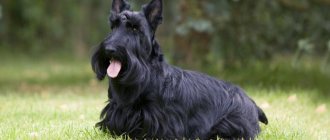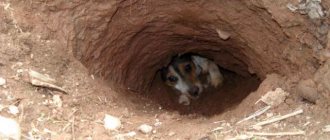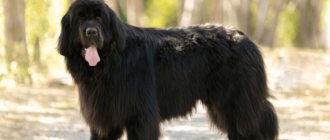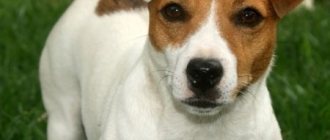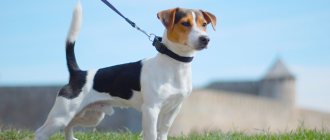Features of the constitution and health
The Jack Russell Terrier is a short dog (half the height is the height of the paws) with semi-dropping ears, the body is elongated and resembles a rectangle. Color – white with dark red markings. Average weight – 20-25 kg. In general, it is a long and short burrowing dog.
Health characteristics and diseases characteristic of this breed
In general, these dogs are in excellent health. However, anything can happen in life. So, the Russells most often have:
- injuries;
- diseases of the musculoskeletal system;
- eye diseases;
- various types of allergies and endocrine diseases;
- ear diseases.
In addition to “their” diseases “by breed,” Russells, like all other dogs, are susceptible to infectious diseases, infestations (helminthic diseases), as well as infections with ectoparasites (fleas, ticks, lice eaters, etc.).
Detailed description of diseases
Injuries
Jack Russells are very active hunting dogs. An imposing sofa life, like the Pekingese, is not for them.
And if the energy is overflowing, then it must be realized, otherwise, with a lack of movement, the dogs try to use the slightest chance for it to splash out.
This is where injuries occur, most often to the musculoskeletal system, tail and ears. Eyes are less likely to be injured (for example, if a dog “flies” into a bush and injures the eye with a branch).
In addition to injury, lack of movement (read: walking!) threatens physical inactivity and all its consequences. These include heart and vascular diseases, obesity, bronchopulmonary diseases, spinal diseases, endocrine and metabolic disorders.
Diseases of the musculoskeletal system
The most frequently recorded diseases are those characteristic of this breed.
Hip dysplasia
This is a hereditary disease in which the socket of the pelvic bone has an irregular, flatter than normal shape. This pathology does not allow the head of the femur to enter the hip joint deeply and tightly enough. Because of this, the dog often experiences injuries such as dislocation, when the head of the femur “falls out” of the socket of the pelvic bone. This occurs especially often during hypermobility and significant physical exertion.
It is difficult for a layman to notice dysplasia, but signs such as:
- stiffness of movement and slightly staggering gait (hind legs);
- unevenly worn claws on the hind legs;
- insufficiently well-developed muscles of the hips/thighs.
The final diagnosis can be made after X-ray examination in certain projections. This can only be done by a veterinary specialist if the necessary equipment is available in the clinic.
There is no cure for hip dysplasia as such. Only maintenance therapy with chondroprotectors, special vitamin complexes for joints and control over physical activity is possible.
Arthritis
This is a general name for inflammation of the joints. Arthritis comes in different forms, but in Jack Russells it most often occurs as a result of excessive activity, hypothermia, and sometimes injury. Less commonly, arthritis can be a consequence of an infection or infestation.
Arthritis is characterized by joint swelling, pain, and sometimes an increase in temperature (local, directly in the area of the affected joint, or general). The dog becomes noticeably less active, limps when moving, and may refuse to eat.
Treating arthritis is a long and difficult process. Self-medication is not only ineffective, but also dangerous. There is a risk of leaving the dog lame for life. Therefore, it is optimal to undergo it under the supervision of a veterinarian.
Legg-Perthes disease
The second name of the pathology is necrosis of the femoral head. The name speaks for itself. The true causes of the disease have not yet been clarified. There are several theories and one of them is heredity, as with dysplasia.
Small breed dogs with short (relative to the body) legs are usually affected by Legg-Perthes disease.
With this pathology, there is a violation of the trophism (nutrition) of the hip joint/joints and its gradual necrosis (death, destruction). An accurate diagnosis can only be made with an X-ray examination.
The disease most often manifests itself in puppies, no older than 1 year. You may notice increasing lameness and atrophy (decrease) of muscle mass on the affected limb. When trying to straighten the leg at the hip joint, the dog experiences acute pain, tries to escape, and squeals.
Treatment is provided only by surgical surgery, up to replacement of the joint with an artificial one.
Patella dislocation
The disease is hereditary, typical, like Legg-Perthes disease, for small breed dogs. Appears at different ages. There is a distinction between dislocation “inside” and “outside”. Regardless of the dislocation, “inside” or “outside,” the bones of the kneecap “go beyond” their physiological norm and cause the dog at least discomfort, and at maximum acute pain.
Jack Russell Terrier: description of the breed, photo and character
A breed standard is a description of the exterior characteristics and physical parameters of an animal that it must meet. Such standards exist not only for dogs, but also for:
- cats;
- farm animals, etc.
Jack Russell Terrier on a walk
Let's look at the most important and significant parameters of the Jack Russell Terrier breed standard.
Coat color
Modern representatives of the breed that interests us today, as a rule, are similar to each other. Their fur looks like this:
- it is very short;
- most of the dog’s coat has a milky white tint;
- The white canvas is usually diluted with spots, the color of which can be either red or black (slight variations in shades are allowed).
The color of a dog's coat is predominantly white, decorated with red or black spots
. As for the degree of coat hardness, it can be:
- soft and smooth;
- intermediate;
- hard, bristly.
In any case, such hair covers the dog’s body with an even carpet, creating a protective barrier from bad weather conditions, such as:
- direct sunlight;
- wind;
- rain;
- snow.
Symptoms of pneumonia in dogs
An exception may be those climatic zones where there is summer weather and above-zero temperatures all year round.
Body structure
So that dogs of this breed can overcome considerable distances and loudly frighten a prey that is sitting normally, breeders “equipped” them with a deep chest. However, it cannot be called wide, and this is also a merit of the breeders, since only with a narrow sternum can one climb into a fox’s hole.
The dog's body is very flexible, which initially played a big role when chasing forest animals. Its strength is beyond doubt: an ordinary Jack Russell Terrier can pull its owner's leash almost as hard as a mature shepherd dog.
The body of the Jack Russell Terrier is small and knitted
The height of the dog at the withers, according to the breed standard, varies between the following indicators:
- 25 centimeters;
- 30 centimeters.
The skull of these animals is slightly flattened. The place where the forehead ends and the muzzle begins is marked by a clear transition of levels. The muzzle of the animal is narrow, and completely tapers towards the nose.
The dog's nose is usually black. The eyes of these animals are small in size, but their shape is not protruding, almond-shaped. The eyelids are completely closed, and the edges are painted black.
The ears of dogs of this breed are cropped
The Jack Russell Terrier's ears are initially short, but they are docked along the length of the dog's tail.
The limbs of the animal have smooth forearms, a long and angular shoulder, small, round-shaped ends of the paws, with pads located clearly below.
Of course, today most people who own dogs of this breed do not intend to use them to catch foxes, badgers, rats or any other wild animals. The modern Jack Russell is man's companion and best friend, a family dog. However, in view of the original purposes of her breeding, the talents for catching in her blood are still alive, although they have moved to another, “urban”, so to speak, plane. Now these dogs are happy to catch:
- balls;
- Frisbee;
- sticks;
- rings and other toys.
Frisbee game
That is why any outing with your dog can turn into an exciting game, provided that you are a connoisseur of this kind of activity. It seems to us that there is nothing more healing for a dog and a person than playing together, which heals and strengthens not only their bodies, but also the connection between them.
The activity of these dogs is off the charts: you need to take a toy for a walk or prepare for the fact that you will have to run after your pet a lot
However, it should be noted that if you live in a private house and are seriously worried about the invasion of field mice or rats, do not worry and immediately get a cat. Your versatile dog will cope with this problem too.
Character of the breed
Here it is, the very moment that we mentioned at the beginning of our article. We did this, of course, not by accident.
The fact is that today it has become popular to purchase Jack Russell Terriers for families with children or adults who hate physical activity. The animal's modest dimensions and bright appearance make it look like a toy, but at the same time, this dog is a stubborn hunter who will not tolerate:
- careless and sometimes crippling grabbing of children;
- recumbent lifestyle.
Children and the elderly are not the best owners for this dog.
Unfortunately, it’s a rare person who thinks to study the character and history of a dog’s origin before buying it. Therefore, representatives of the breed we are interested in migrate en masse to human families. Their further fate is determined precisely by the society into which they found themselves:
- avid dog lovers and activists establish contact with the animal;
- passive individuals and ill-mannered parents oppress the animal.
In the second case, oppression, in the most favorable scenario, is limited to rare and short walks with the animal. Unfortunately, this alone can lead to a serious reduction in his life expectancy and the development of many diseases. However, it is often worse. An active dog that does not allow itself to be offended by “playing” children:
- are given into the wrong hands;
- punished with beatings;
- starving;
- they don’t take you to veterinarians, etc.
With an adequate approach, communicating with your dog will bring you pure pleasure.
People are often not stopped by the fact that they spent a lot of money on purchasing a pet. But all you had to do was take an interest in the past of the breed, and understand that there is no place for an active hunter of livestock in the measured life of your social unit. However, if you are an adequate, tolerant person who understands the needs of dogs, then you will be able to get along with these terriers. Among all the varieties of Russell Terriers, it is the “Jacks” that are the most balanced. This manifests itself primarily in:
- their focus on people;
- love;
- adoration of caresses;
- compliant nature;
- readiness to instantly respond to commands;
- Barking is not as frequent as that of its relatives.
Jack Russell Terriers love affection
An absolute plus of the breed is trainability. Dogs suitable for hunting must obey their owner unquestioningly and literally predict his wishes. Unlike many other types of dogs, they calmly accept “boring” training when the owner practices the same command many times. At the same time, they can lie down, give a paw, and bark even without reinforcement of the action with a treat.
Mini agility competitions held in Britain (a sport for dogs) are most often won by Jack Russell Terriers, who are born to take part in such sports competitions, somewhat reminiscent of hunting.
We invite you to read: Angora rabbit - history, care, feeding, breeding, the main value of the fluffy breed
It is important that a potential Jack Russell owner remembers that this dog is a working dog and should always be kept busy.
Sufficient physical activity of these dogs is the key to the integrity of your furniture and other household items.
No, you shouldn’t populate your house with rats or badgers, it will be enough:
- do dog training;
- regularly conduct sports training for the dog (and at the same time for yourself);
- if possible, take the animal to competitions;
- Walk the dog for a sufficient amount of time.
Provided that you refuse your pet even the smallest thing, a walk, he will bring you more sadness than joy, as he will get bored and begin:
- chew furniture;
- dig parquet;
- bark loudly;
- shit anywhere;
- stop responding to commands, etc.
Jack Russell needs active walks
In addition, training for this small breed is also highly recommended because this dog is simply meant for it. The created discipline will help not only control the dog’s level of controllability in critical situations, but also increase the efficiency of interaction with it.
It is strictly forbidden to give a dog to children or elderly people. This dog on a walk will pull the owner to explore all the gullies, hills, ravines, etc. Neither a child nor an elderly person will be able to withstand dog travel and will let go of the leash. This is where another Jack Russell character trait comes into play - the love of running away. Yes, he won’t run far from you, but catching a pet running around the neighborhood can take more than one hour.
Barking is another stumbling block between dog lovers and this breed. Despite the fact that Jacks bark less than their other close relatives, this is still enough for human ears.
Education and discipline are the only way to be quiet sometimes
Unfortunately, another controversial and unexpected thing for many new owners of Jack Russells is their attitude towards people and other animals. We want to say right away that everything will be fine within the family if:
- you will really love the animal;
- educate him properly;
- Explain to your child, if you have one, that a dog is not a toy, but a living being.
Love for the owner and his pack, like that of any other dog breed, is the dominant feature of the Jack Russell. They get along well with children if they are careful with them, and playing with kids can become their favorite pastime.
The Jack Russell is a dog that is very tolerant of children, however, it will not play with a child if he grabs it mercilessly
However, family friends or strangers will have a hard time, because for the dog they are strangers, and it will treat new personalities with the utmost caution.
As for other animals, here, unfortunately, everything is even worse. Very often these dogs show aggression towards their own kind, and even hunt cats and other small animals. The only option when a cat can be mistaken for a friend, and not a piece of meat, is when the Russell puppy grew up with her in the same apartment.
An animal can either be friends with other dogs or not play, or even fight at the first meeting
Prevention of infectious and invasive diseases
In addition to diseases specific to the breed, Jack Russells can suffer from serious infections and infestations. We briefly mentioned this at the very beginning of the article.
So, to prevent these troubles, there is vaccination (preventive vaccinations).
Vaccinations for puppies and by age
Dogs are vaccinated according to the epizootic situation in the region where the dog lives and the vaccination scheme developed by veterinary specialists. By analogy with human prevention of infectious diseases - the national vaccination calendar.
This is a very effective measure in preventing dangerous infections. All dog owners who take good care of their dogs strictly monitor immunization.
You can get your dog vaccinated at any veterinary clinic.
Prevention of infestations (helminthiases, helminthic diseases) in dogs should be carried out from 1.5 months of age and throughout life, every 3-6 months, depending on the type of feeding and living conditions.
Jack Russell Terrier: description of the breed, photo and character
Unfortunately, the statistics collected regarding whether this breed lives up to the expectations of its new owners is very disappointing. To understand why people who are eager to purchase this dog regret purchasing it after a while, we will have to look into the history of the breed. Thus, the Jack Russell Terrier is a dog that was originally bred as a first-class hunter of foxes and other similar forest animals.
Along the way, breeders also gave her the following abilities:
- a passionate rat catcher;
- a dog that, despite its size, is capable of guarding and guarding.
Surprisingly, today the Jack Russell Terrier, which was invented for fox hunting, can not only not be at enmity with these domesticated pets, but also be friends, because they, in fact, are representatives of the same family
The main talent of the Jack Russell is finding the burrows of wild animals. In addition to the fact that it was necessary to find sometimes very inconspicuous and small holes, these dogs also faced the following tasks:
- drive the animal to the surface with loud barks or growls;
- provided that the animal did not succumb to provocation, the dog had to grab onto it and pull it to the surface.
We suggest you read: The most common diseases of toy terriers
By the way, these dogs used to work in pairs with representatives of another breed. So, back in the 18th century, in Europe, when representatives of the upper classes hunted foxes, and considered this fun to be really relevant, the main process took place with the help of English paratha hounds or the so-called foxhounds - “fox dogs”. Foxes, not because their appearance resembled a fox, but because that was what they hunted.
Foxhound is a fox hunting partner for fox terriers
The foxhound's task was to bring the victim to complete exhaustion, so the animals chased it throughout the forest. The fox had only one chance of salvation: its hole. However, as soon as the animal hid in a hole in the ground, the ancestors of the Jack Russell Terriers entered the arena and had to lure the animal out of the hole or pull it out by force.
So, initially there were no Jack Russell Terriers. Their place was taken by fox terriers, which, by the way, are still widespread today in their original breed form. It was these dogs, significantly smaller in size than their hunting partners, that determined how the hunt would end.
Fox Terrier - ancestor of Jack Russell Terriers
Work on breeding the fox terrier began a long time ago, at the beginning of the 19th century. Initially, these dogs were as unattractive as possible:
- they had a knitted, stocky and angular body;
- the neck of these animals was too short;
- the head looked like a brick, as it was wide and had an ugly shape.
No attention was paid to the appearance of the dog, since in those distant years such a concept, in principle, meant little. The main task of breeders of those times was to impart valuable physical and mental qualities to the breed. Specifically in this case it was:
- about physical and mental endurance;
- the strength of the animal's muscle corset;
- the obvious malice that helped these hunting dogs drive down game.
However, already in 1859, requirements regarding the beauty of animals appeared in Europe. So, in 1859 in England, which is the birthplace of the breed we are considering today, countless dog shows began.
Scene of a traditional English hunt: among the foxhounds you can also see a fox terrier
People noticed that the dog began to win the greatest sympathy from the judges and spectators:
- with well-developed service qualities;
- having the most pleasing exterior.
As soon as the understanding of the need to improve the appearance of dogs came, breeding work began to boil with renewed vigor. After some time, puppies born in litters ceased to resemble their ancestors. They purchased:
- true English elegance;
- compact dimensions;
- smoothness of features
At the same time, the breed’s qualities have not lost any strength, but, on the contrary, have seriously improved. The breed was officially recognized only in 1870, when the English Kennel Club began to:
- exercising control over breeding activities;
- scheduling of breed standards.
Due to its outstanding external and behavioral, as well as physical characteristics, this breed began to rapidly conquer England and all of Europe as a whole.
After some time, these dogs turned from hunters into catwalk models
Thus, by 1880, its representatives at exhibitions represented approximately 1/5 of the total number of dogs that were presented at it. At the same time, the attention of the audience was incessant. By the way, many of them returned a few years later to the exhibition as participants, again leading the same dog on a leash.
The love for shows and fox terriers led to the fact that in the process of further selection the appearance of these dogs was seriously modified
Now, instead of a wide and knocked down “bedside table”, a dog appeared in front of people, which had:
- deep, developed chest;
- straight shoulders;
- narrow and elongated head.
Over time, the dog breeding stratum of England was divided into two camps.
In the 19th century, a serious battle broke out between fox terrier lovers over the question of who these dogs were - hunters or catwalk divas?
Table. Directions in the selection of fox terriers (England, 19th century)
| Breeders of original hunting lines | Owners of new show-class dog kennels |
| Representatives of this category, as a rule, were hunters. On the basis of their estates, they bred this breed of dogs, which retained the unchanged features of their ancestors: |
- angularity;
- strong muscle corset;
- wild anger at forest animals;
- wide head;
- stable paws;
- wide chest, etc.
These dogs have always been working dogs. They successfully helped catch many foxes, as well as other game that the owner set them on.Pets in this category, even in a dream, could not see themselves at the exhibition for two reasons:
- their appearance did not allow them to compete with even the ugliest representative of show-class fox terriers;
- The owners of this original working line of dogs hated the updated representatives of the breed and those who bred them, so for them to send their dog to the show was an unforgivable crime. More progressive citizens of Europe, who had little to do with such a cruel form of entertainment as hunting, on the contrary, advocated for further improvement of the external characteristics of the updated representatives of the breed. The hunter dog became a member of the show class category, and was now bred not on the estates of hunting enthusiasts, but in specialized nurseries, where puppies were looked after from birth like gold bars.
- more calm;
- somewhat human-oriented;
- somewhat softer.
Kennel owners were not without prejudices regarding those who bred the original breed of these dogs, since they believed that both their cruel entertainment and the aggressive dog acting as a tool for driving game had become obsolete. - spiritual career;
- fox hunting, which is just gaining “fashionable” momentum.
The dogs that were bred in these kennels, despite maintaining a somewhat wild disposition and anger towards the forest inhabitants, became:
We suggest you familiarize yourself with: Scotch Terrier color
Reverend Jack Russell is the same man who completed the work of breeders and gave the society of dog lovers a well-known animal, which is very popular today to have as a pet.
This is how the Jack Russell Terrier became what we know it today
What’s interesting is that this man was originally engaged in breeding the hunting variety of terriers, and he also judged at exhibition events. However, he never showed off his own animals, since he had a clear opinion on this matter: pleasing fashion in relation to dogs is the last thing.
But we got ahead of ourselves.
Jack Russell is a man known to all dog breeders in the world
Even before the above-mentioned new varieties of fox terriers (the same “Russells”) appeared, the history of communication between the reverend and these dogs was already filled with interesting nuances. Thus, the first terrier with a traditional exterior, physical abilities and other characteristics was bought by the reverend back in 1814. At that time, this outstanding person was just 19 years old. His main passions at that time were:
Then the monk did not even suspect that heaven had not reserved for him the role of a priest. He will devote his entire future life, namely 65 years, to breeding ideal representatives of his favorite dog breed.
The white fox terrier Trump became the founder of a new breed that has worldwide fame
But in 1814, a young representative of the church stood and looked at a white dog with smooth fur, which attracted him with its color, unusual physique and active character. The dog to some extent reminded Jack Russell of a fox. At one point, she sank into his soul, and he turned to the pet’s owner, a local milkman, with a request to buy the animal.
After some time, the parties were able to come to an agreement, and the dog passed into the hands of the monk. After some time, the priest realized that the animal named Trump was actually a hunter, just look for him. Plus, despite belonging to the Fox Terrier breed, he was strikingly different in appearance from the Scottish representatives of the breed, which were characterized by:
- paws too thin;
- tangled shaggy fur.
Burrowing is one of the basic instincts of Jack Russell Terriers.
Body structure
Smooth Jack Russell Terrier
Advice from an expert
A lot has been said above. There is only one conclusion from this - when buying a puppy, do not be lazy, check all the information about the health of its parents, and their parents too.
Before giving money to the breeder, ask him for a complete veterinary report on the condition of the puppy. Please note that there is information about the musculoskeletal system, the condition of the eyes and ears, hearing and vision, skin and of course about all preventive procedures, such as treatment for fleas, worms and vaccinations.


